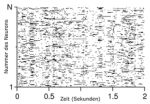 There is a surprising rate at which neuronal networks in the cerebral cortex delete sensory information, and the dynamics behind signal transmission in the brain are extremely chaotic. These conclusions were reached by scientists from the Max Planck Institute for Dynamics and Self-Organization at the University of Göttingen and the Bernstein Center for Computational Neuroscience Göttingen.
There is a surprising rate at which neuronal networks in the cerebral cortex delete sensory information, and the dynamics behind signal transmission in the brain are extremely chaotic. These conclusions were reached by scientists from the Max Planck Institute for Dynamics and Self-Organization at the University of Göttingen and the Bernstein Center for Computational Neuroscience Göttingen.
In addition, the Göttingen-based researchers calculated for the first time how quickly information stored in the activity patterns of the cerebral cortex neurons is discarded. At one bit per active neuron per second, the speed at which this information is forgotten is surprisingly high.
The brain codes information in the form of electrical pulses, known as spikes. Each of the brain’s approximately 100 billion interconnected neurons acts as both a receiver and transmitter: these bundle all incoming electrical pulses and, under certain circumstances, forward a pulse of their own to their neighbours. In this way, each piece of information processed by the brain generates its own activity pattern. This indicates which neuron sent an impulse to its neighbors; in other words, which neuron was active, and when. Therefore, the activity pattern is a kind of communication protocol that records the exchange of information between neurons.

An activity pattern is comparable to a communication protocol. It indicates which neuron is active at a given time. Credit - MPI for Dynamics and Selforganisation
The new results obtained by the scientists in Göttingen have revealed that the processes in the cerebral cortex, the brain’s main switching centrer, are extremely chaotic. The fact that the researchers used a realistic model of the neurons in their calculations for the first time was crucial. When a spike enters a neuron, an additional electric potential forms on its cell membrane. The neuron only becomes active when this potential exceeds a critical value. “This process is very important,” says Fred Wolf, head of the Theoretical Neurophysics research group at the Max Planck Institute for Dynamics and Self-Organization. “This is the only way that the uncertainty as to when a neuron becomes active can be taken into account precisely in the calculations”.

Michael Monteforte and Fred Wolf discuss their findings. Credit - MPI for Dynamics and Selforganization
Thanks to their more differentiated approach, the Göttingen-based researchers were able to calculate for the first time how quickly an activity pattern is lost through tiny changes; in other words, how it is forgotten. Approximately one bit of information disappears per active neuron per second. “This extraordinarily high deletion rate came as a huge surprise to us,” says Wolf. It appears that information is lost in the brain as quickly as it can be “delivered” from the senses.
This has fundamental consequences for our understanding of the neural code of the cerebral cortex. Due to the high deletion rate, information about sensory input signals can only be maintained for a few spikes. These new findings therefore indicate that the dynamics of the cerebral cortex are specifically tailored to the processing of brief snapshots of the outside world.
Material adapted from Max-Planck-Gesellschaft.
Reference
Physical Review Letters, 105, 268104 (2010).
No comments yet.